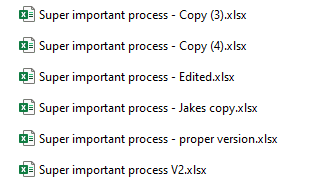Should this Spreadsheet be a System?
5 signs that the answer is yes
It’s pretty normal for an organisation to have spreadsheets here or there which are helping manage a process or function. Many processes
start by a team or team member hashing out the information in a spreadsheet. The fact that it is easier than ever to collaborate in Excel
makes it even more inviting.

On our path to digital transformation, we should be uncovering these spreadsheets and evaluating their use. It’s important that teams
shouldn’t feel the need to hide these away, rather we should be helping them to improve how they manage data so they can achieve more to a
higher level of quality.
There are good reasons to evaluate if a spreadsheet should be moved to a system. Thankfully, these days we
have many more options
for how to proceed and the cost of implementing and running these is very much reduced.
1. Would losing rows or cells of data hurt?
Despite some advancements with change tracking and previous versions, Excel really isn’t great at handling data loss. That’s ok because it isn’t designed to be used for managing work where data integrity matters. If losing a row or cell and not knowing what was there would hurt your business, then a system with a database is a better idea.

Databases are much better at preventing loss and tracking changes. For example, instead of deleting a row completely, often the system can
mark that row as inactive which means that it can still be recovered easily.
2. Do you need to see a history of changes?
This one is very similar to the thought of losing data. If things change in a spreadsheet and you don’t know who changed them, what the
previous value was, why it changed or when it changed then the process very quickly breaks down.

Logging in a system can be useful. There are different levels of logging and audit logs, but at least very basic change logging can save
your bacon!
3. Do you need to control access and the ability to make changes?
Would you like someone to only view the data, whilst another person should be able to edit parts but not all? What about deleting items? Maybe everyone should be able to create new items? Achieving this in Excel would require some workarounds and a lot of management.
Even a simple system that can have roles allocated means we can achieve whatever levels of access are required.
4. Would automation such as notification of due dates be useful?
Imagine you have a simple register of accreditations that need to be renewed. You could manually open your spreadsheet every week and review
these. A better idea might be to have these in a simple database with a workflow that runs once a week and emails you a list of items
expiring soon.

Generally, once data is in a capable system then the automation and workflows that can assist you are usually only limited by your
creativity and the resources to implement them. Thankfully with low-code solutions like MS Power Automate, the cost of implementation is
drastically reduced.
5. Is the spreadsheet being duplicated?

I see this one a lot. Someone wants to work on the spreadsheet without impacting others, so they make a copy. Then at some point it is
realised that the changes really need to be in the main version. Worse still, sometimes people don’t realise that they are working on
different versions of the spreadsheet. Sometimes weeks or months can go by and then there is a huge task to merge the two.
It’s messy and risky if the data is at all important.
Conclusion
As we evaluate how we are using spreadsheets, we need to consider the risks and available options.
In a different post I examine some paths to systemising these spreadsheets.


Leave a Comment